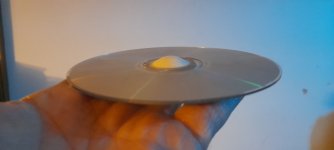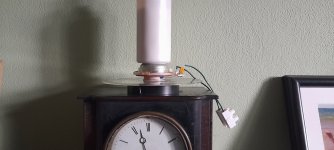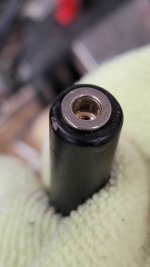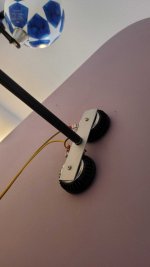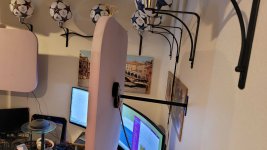There are two things at play here...And this #5136 from HCSebastian where clarity is more associated to 2kHz (listed in the history file)
One is the obvious 3.2khz presence boost which, on a mic channel, will let the voice cut through other instruments.
The other trick is to take out the fundamental around 250-400hz which tends to remove the mud out of the mix. This usually improves vocal clarity too.
Christian,@Veleric + REW users
Please find attached the REW "tuto" file already shared. I added some pages to show how I have wired the loopback time reference (see previous post about in panel wave speed)
Christian
PS : please find in my signature in the left panel the link to my page Homeswinghome under github.com where the files I have shared in this thread are going to be stored (history file and REW tuto available). Let me know if it doesn't work... correction of English also welcome.
I hope I don't disappoint you too much, but as I am not an electronics engineer the loopback time reference is still a bit beyond current abilities. But I'm eager to see if it gives you a different result than the built-in timing references in REW. Now that you have your timing reference sorted, I assume you have some more wave speed tests in planning, right? In theory, if the delay measurement is sufficiently accurate, it would provide a method of evaluating how the bending stiffness varies as a function of frequency. But I still fear that the delays are so small that the accuracy needed to back calculate bending stiffness will be difficult to obtain.
I checked out your signature and saw he links to the Eucy's domes and Burnt's Tall Story Notes, but no links yet for the history file or REW tuto. Am I missing them or they are not added yet?
Eric
Hello EricChristian,
I hope I don't disappoint you too much, but as I am not an electronics engineer the loopback time reference is still a bit beyond current abilities. But I'm eager to see if it gives you a different result than the built-in timing references in REW. Now that you have your timing reference sorted, I assume you have some more wave speed tests in planning, right? In theory, if the delay measurement is sufficiently accurate, it would provide a method of evaluating how the bending stiffness varies as a function of frequency. But I still fear that the delays are so small that the accuracy needed to back calculate bending stiffness will be difficult to obtain.
I checked out your signature and saw he links to the Eucy's domes and Burnt's Tall Story Notes, but no links yet for the history file or REW tuto. Am I missing them or they are not added yet?
Eric
About loopback, it was my fear when I made the schematics to describe something too complicated. We will see if other feedback bring simpler solutions. The principle is shown, the devices used can change.
By the way, don't be afraid by some electronic components... not more difficult than building panels or dealing with FEM.
Yes I have put in my do list to do some more tests... a matter of time. But first, I have to use the last records.
Your remark about the delays and the precision is very good. To keep in mind. The speed in HF is high, an error of measurement is possible. Nevertheless the mid frequency area might give good information. To see if a limitation of speed with a material with a low shear module (G) is visible is an other question. So to push further.
Thank you for the feedback about the Github link (1st time I use such tool). The link was wrong. It leads to the readme file not the main page. Correction done. You should see above this read me a list of files. You can open them in the Github pdf reader directly in your browser or download then for a better reading.
Christian,Hello Eric
About loopback, it was my fear when I made the schematics to describe something too complicated. We will see if other feedback bring simpler solutions. The principle is shown, the devices used can change.
By the way, don't be afraid by some electronic components... not more difficult than building panels or dealing with FEM.
Yes I have put in my do list to do some more tests... a matter of time. But first, I have to use the last records.
Your remark about the delays and the precision is very good. To keep in mind. The speed in HF is high, an error of measurement is possible. Nevertheless the mid frequency area might give good information. To see if a limitation of speed with a material with a low shear module (G) is visible is an other question. So to push further.
Thank you for the feedback about the Github link (1st time I use such tool). The link was wrong. It leads to the readme file not the main page. Correction done. You should see above this read me a list of files. You can open them in the Github pdf reader directly in your browser or download then for a better reading.
I'm looking forward to your next tests with the timing reference.
Not sure what you meant when you wrote- But first, I have to use the last records.
Your Github links seem to be working now. I actually re-read Burnt's Tall Story and realized how many similarities there are between his methods and my own. I suspect I learned more from that write up when I first read it than I realized. Thanks Burnt
Concerning wave speed and the effect of shear modulus I recently came across the article directly below, which was one of the references in a link hilbren posted recently (2nd link below). Near the end of the paper, in sections 3.1 and 3.2, he contends that one advantage of a sandwich core composite for DML is the limitation on wave speed due to the shear modulus of the core. He says it keeps the wave speed below critical speed for a wider frequency range than would be the case if the shear modulus was higher.
https://mycourses.aalto.fi/pluginfile.php/1238697/mod_resource/content/1/Radiation-Mechanisms.pdf
https://riunet.upv.es/bitstream/handle/10251/3347/tesisUPV2873.pdf
Eric
I got an idea to use a CD/DVD disc as a panel. I could find in this thread that this has been tried before. How about a vinyl/LP?
You are very welcome Eric. I have learnt a lot from you as well. The more we share the more we learn
Hello Pelanj,I got an idea to use a CD/DVD disc as a panel. I could find in this thread that this has been tried before. How about a vinyl/LP?
Have a look to 5118, 5119, 5124, 5127 from last March. I don't remember post with vinyl. One drawback of those materials if they are heavy so a low efficiency (some where you should find the efficiency if related to E/rho³, E Young modulus, rho density). No advantages are for now identified for them... as far as I remember...
Christian
Eric,Christian,
I'm looking forward to your next tests with the timing reference.
Not sure what you meant when you wrote- But first, I have to use the last records.
Your Github links seem to be working now. I actually re-read Burnt's Tall Story and realized how many similarities there are between his methods and my own. I suspect I learned more from that write up when I first read it than I realized. Thanks Burnt
Concerning wave speed and the effect of shear modulus I recently came across the article directly below, which was one of the references in a link hilbren posted recently (2nd link below). Near the end of the paper, in sections 3.1 and 3.2, he contends that one advantage of a sandwich core composite for DML is the limitation on wave speed due to the shear modulus of the core. He says it keeps the wave speed below critical speed for a wider frequency range than would be the case if the shear modulus was higher.
https://mycourses.aalto.fi/pluginfile.php/1238697/mod_resource/content/1/Radiation-Mechanisms.pdf
https://riunet.upv.es/bitstream/handle/10251/3347/tesisUPV2873.pdf
Eric
I just wanted to mention I have not really used yet the records I made 2 weeks ago (the "last records", I shared 2 of them).
Good news for the link and I am happy if it is the possibility for you to read again some documents. I have some other documents to add... If one or several of us has (have) a bibliography with the link to the documents it would be great. I have the list of the document I have stored (easy to get from a folder) but unfortunately without the link to the source.
About the wave speed and the shear modulus, funny situation, I was thinking the same today!
Le savoir est la seule matière qui s'accroît quand on la partage / Knowledge is the only thing that grows when you share it. Supposed to be from Socrates (said with the French version, no mention of him in English)You are very welcome Eric. I have learnt a lot from you as well. The more we share the more we learn
Does Socrates know the DML and this thread?
I came across this old CD panel a couple of days ago while looking for some tools.I got an idea to use a CD/DVD disc as a panel. I could find in this thread that this has been tried before. How about a vinyl/LP?
I never got around to putting the exciter on, this is the eggshell tweeter , slightly offset I noticed.
LPs were very thin in the 70s like poppadoms and sounded very similar, they maybe a better bet for a panel ?
Steve.
Attachments
Sunny side up???😊I came across this old CD panel a couple of days ago while looking for some tools.
I never got around to putting the exciter on, this is the eggshell tweeter , slightly offset I noticed.
LPs were very thin in the 70s like poppadoms and sounded very similar, they maybe a better bet for a panel ?
Steve.
Cool. I just wanted to use CD or LP for looks. So while far from optimal, it may work. Let me ask one more beginner question, how does one fix an exciter semi-permanently for experiments with different panel materials? The original double sided tape will become unusable after a few panels I guess. I remember reading some tips about permanent installations here, but what is best for temporary? Should I just cut a piece of double sided tape then with a hole in the middle?
I've used Prestick, (Bluetack?) double-side tape, Wondafix, Hotglue, and all kinds of other adhesive to fix the drivers to different surfaces. You just have to be careful when you remove the driver.Cool. I just wanted to use CD or LP for looks. So while far from optimal, it may work. Let me ask one more beginner question, how does one fix an exciter semi-permanently for experiments with different panel materials? The original double sided tape will become unusable after a few panels I guess. I remember reading some tips about permanent installations here, but what is best for temporary? Should I just cut a piece of double sided tape then with a hole in the middle?
Both Tectonic and Dayton do provide drivers with screw-attachment rings for testing purposes... You unscrew the driver from its mounting ring when finished testing, and then either screw it onto a different ring, or carefully pry the ring off its test surface.
See post #5,741 for my method pelanjCool. I just wanted to use CD or LP for looks. So while far from optimal, it may work. Let me ask one more beginner question, how does one fix an exciter semi-permanently for experiments with different panel materials? The original double sided tape will become unusable after a few panels I guess. I remember reading some tips about permanent installations here, but what is best for temporary? Should I just cut a piece of double sided tape then with a hole in the middle?
Eucy
Pelanj.
I had a quick listen to the CD panel, it produces quite a lot of exciter noise.
This could be being made worse by the egg dome, so I will remove the dome and see.
The noise is unacceptable and is similar to the crate ply, but is easy to reduce with a couple of blobs of carefully placed bluetack.
I would think a vinyl record may be a better choice of material, though not tested as yet ?
When I get time I will post some pictures and plots, maybe.
Steve.
I had a quick listen to the CD panel, it produces quite a lot of exciter noise.
This could be being made worse by the egg dome, so I will remove the dome and see.
The noise is unacceptable and is similar to the crate ply, but is easy to reduce with a couple of blobs of carefully placed bluetack.
I would think a vinyl record may be a better choice of material, though not tested as yet ?
When I get time I will post some pictures and plots, maybe.
Steve.
Haven't gone through the 337 pages of awesomeness (yet) -- but just wanted to post how I mounted my basic dual exciter panels. Gonna run cleaner wiring 🙂
They seem to now require more power to get volume, but once up there they may sound better than just suspended (non-scientific observation).
I used 'hidden' mount shelf brackets, drilled a hole through the end, added a nutsert, and then used a small piece of aluminum (old text worn ruler). I also used neoprene washers to deaden the vibration into the bracket/wall.
Have these paired with a Paradigm PS1200 sub (which I just did foam surround repair on).
They seem to now require more power to get volume, but once up there they may sound better than just suspended (non-scientific observation).
I used 'hidden' mount shelf brackets, drilled a hole through the end, added a nutsert, and then used a small piece of aluminum (old text worn ruler). I also used neoprene washers to deaden the vibration into the bracket/wall.
Have these paired with a Paradigm PS1200 sub (which I just did foam surround repair on).
Attachments
I like it. You can use liquid leather dye to color those panels. I used black for mine and applied over my PVA/water coating and seemed to work just fine. Two coats crisscrossed. How many watts are those exciters? Two are way overkill for EXP panels that size in my testing (24w), but I see you got your 8ohm by using 2 so never mind.Haven't gone through the 337 pages of awesomeness (yet) -- but just wanted to post how I mounted my basic dual exciter panels. Gonna run cleaner wiring 🙂
They seem to now require more power to get volume, but once up there they may sound better than just suspended (non-scientific observation).
I used 'hidden' mount shelf brackets, drilled a hole through the end, added a nutsert, and then used a small piece of aluminum (old text worn ruler). I also used neoprene washers to deaden the vibration into the bracket/wall.
Have these paired with a Paradigm PS1200 sub (which I just did foam surround repair on).
Last edited:
- Home
- Loudspeakers
- Full Range
- A Study of DMLs as a Full Range Speaker
